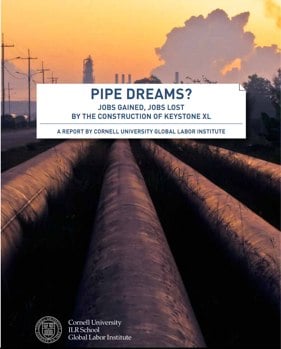Proponents of the controversial Keystone XL pipeline project would like you to believe that, if approved, its construction will put hundreds of thousands of Americans to work. This is plainly untrue, according to a new report by the Cornell University Global Labor Institute.
TransCanada, the Canadian company behind the project, has spent the past few years making ambitious claims about the jobs that would be created by construction of the pipeline, which would carry diluted bitumen (or DilBit) crude 1,700 miles across six Great Plains states, 1,904 waterways, and the nation’s largest freshwater aquifer.
These jobs claims have grown more optimistic as the project has found itself the subject of increased scrutiny. This National Wildlife Federation post rounds up TransCanada’s mysteriously rising jobs claims:
In 2008, a report included in TransCanada’s Presidential Permit application for Keystone XL to the State Department said they anticipate “a peak workforce of approximately 3,500 to 4,200 construction personnel” to build the pipeline. In 2010, TransCanada put out a press release that said, “During construction, Keystone XL would create 13,000 jobs and further produce 118,000 spin-off jobs.” In 2011, TransCanada put out a fact sheet that said Keystone XL would “create about 20,000 construction and manufacturing jobs.”
In reality, according to the exhaustively researched Cornell report, even the earliest, most modest claims seem unrealistic.
In fact, in Pipe Dreams? Jobs Gained, Jobs Lost by the Construction of Keystone XL, the institute says more jobs could actually be destroyed than created by the pipeline.
Let’s dive into the Cornell research. Here are a few of the report’s main findings that, by my reading, were most convincing.
» The industry’s US jobs claims are linked to a $7 billion KXL project budget. However, the budget for KXL that will have a bearing on US jobs figures is dramatically lower—only around $3 to $4 billion. A lower project budget means fewer jobs.
That $7 billion figure is everywhere in TransCanada’s literature, but $1.6 billion of that is for the Canadian portion of the pipeline, which wouldn’t impact American jobs. Another $1.3 billion is already committed to be spent, whether or not the pipeline is approved. Only $3.9 billion in the project’s budget for both the U.S. and Canadian portions of the pipeline, according to TransCanada’s own financial statements. The report calculates that only between $3 to $4 billion would be spent within the U.S.
» The project will create no more than 2,500-4,650 temporary direct construction jobs for two years, according to TransCanada’s own data supplied to the State Department.
» The company’s claim that KXL will create 20,000 direct construction and manufacturing jobs in the U.S is not substantiated.
Based on jobs information provided by the company for the Environmental Impact Statement, on-site construction and inspection would create 5,060-9,250 person-years of employment (labor terms for one person working full time for one year). This equals 2,500-4,650 jobs per year over two years.
More troubling are the numbers for local jobs. TransCanada and proponents of Keystone XL have been barnstorming in local communities along the pipeline’s route with promises of jobs. But the Cornell report finds that “just 500 to 900 workers are expected to be hired locally—roughly 10-15% of the total workers hired.” Here’s the state-by-state breakdown, based again on data provided to the State Department by TransCanada:
- Montana: 93 and 257 jobs for residents in Montana
- South Dakota: 121-333 jobs
- Nebraska: 90-248 jobs
- Kansas: 6-18 jobs
- Oklahoma: 41-113 jobs
- Texas: 156-470 jobs
Some empirical evidence backs up this bias against local hiring. During construction of Keystone’s Phase 1, TransCanada employed a total of 2,580 workers in South Dakota, but only 282 workers were residents of the state.
» There is strong evidence to suggest that a large portion of the primary material input for KXL—steel pipe—will not even be produced in the United States. A substantial amount of pipe has already been manufactured in advance of pipeline permit issuance.
TransCanada has already signed contracts for nearly 50 percent of the steel pipe for the project. A Russian company, Evraz, will manufacture roughly 40 percent in Canadian mills, and an Indian company, Welspun, is likely to produce the rest. Shipping and customs records reveal that TransCanada has already imported over 70,000 tons (nearly 10 percent of the total required in the project) of the carbon steel pipe from Welspun since April of this year.
» The industry’s claim that KXL will create 119,000 total jobs (direct, indirect, and induced) is based on a flawed and poorly documented study commissioned by TransCanada (The Perryman Group study). Perryman wrongly includes over $1 billion in spending and over 10,000 person-years of employment for a section of the Keystone project in Kansas and Oklahoma that is not part of KXL and has already been built.
Specifically, the faulty Perryman study redefines the KXL project to include Keystone’s Phase 2, a 298 mile 36-inch pipeline from Steele City, Nebraska to Cushing, Oklahoma that was built in 2010 and fully in-service as of February 2011. In other words, Perryman included more than $1 billion in prospective spending that has already occurred.
Finally, most troubling takeaways of Pipe Dreams was buried on page 25 of the report.
Based on TransCanada’s own figures provided to the Canadian government, operating costs for the U.S. section of their pipeline are minimal, and new permanent American jobs created would likely be as few as 50.
The report goes on in its final section to discuss the ways that construction of Keystone XL could actually cost America jobs, based on increased fuel costs and the expenses related to accidents and spills. The data and research behind these theories is far from complete, but it certainly raises a valid concern. More work should be done studying the economic and labor impacts of accidents and pollution, and the real economic costs of bypassing the Midwest with this crude needs to be better examined.
Of course construction of a massive 1,700 mile long steel pipeline will create some jobs. But TransCanada’s claims are vastly overstated, and the contradictions between the figures in their public outreach and their official submissions to the government are startling. It’s impossible to know now if Keystone XL would be a net job creator or if it would cost America jobs. But that deep level of uncertainty should be a big red flag.
Subscribe to our newsletter
Stay up to date with DeSmog news and alerts







